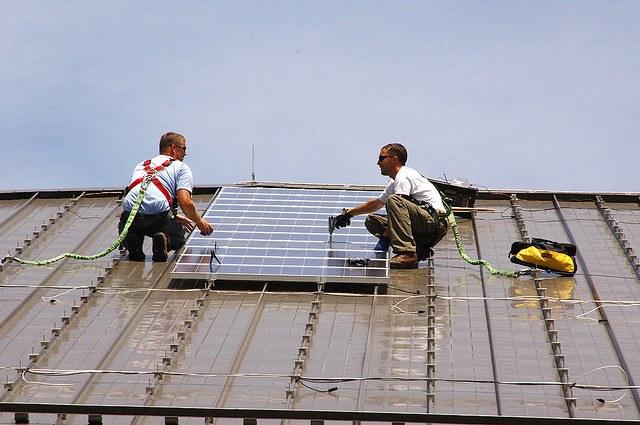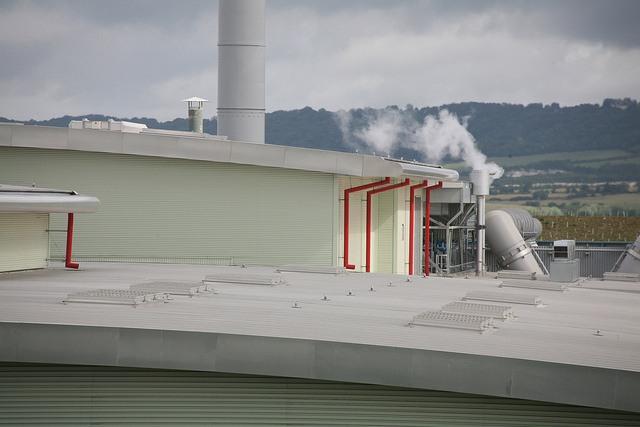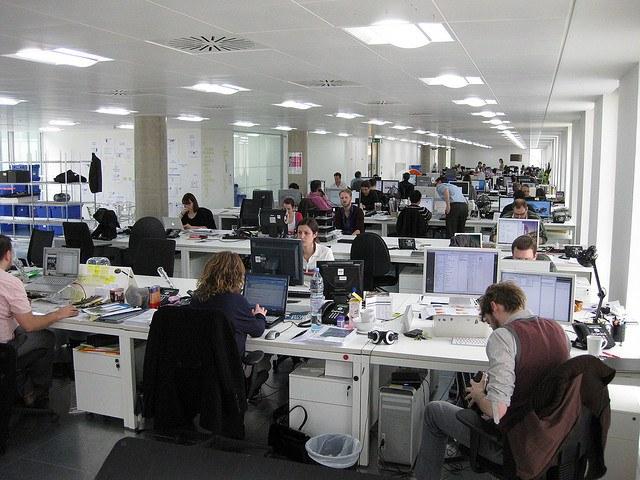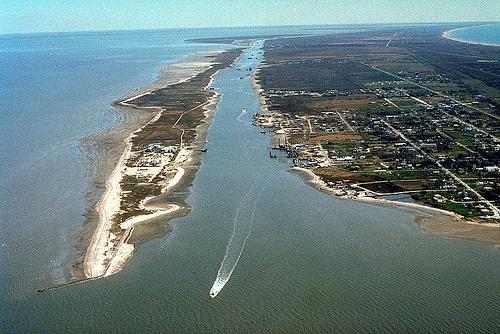Clean Energy Trends 2014: New Solar Energy Capacity Exceeds Wind For First Time


The landscape of the global renewable energy market continues to shift with changes in economic and social conditions and policies. While some renewable energy sectors – notably, solar photovoltaic (PV) deployment – experienced “dazzling growth, success and rising stock prices,” others saw a drop in deployments, as well as challenges on the policy and finance fronts, according to a global clean energy market report from Clean Edge released March 26.
Last year marked a turning point for solar PV, according to Clean Edge's, Clean Energy Trends 2014 report, as newly installed solar PV generating capacity exceeded that of wind power for the first time since the market research company began tracking global markets in 2000. Newly installed solar PV generating capacity totaled 36.5 gigawatts (GW) while that for wind totaled 35.5 GW, according to Clean Edge's count.
A crossover for solar PV
Fueling solar PV capacity growth, new installations hit record levels in China, Japan and the U.S. in 2013. That combined with a decline in new wind power capacity led to “this unprecedented crossover,” Clean Edge explained in a press release.
The global solar PV market grew 15 percent in value in 2013, with modest growth in biofuels. Combined, growth in the two sectors wasn't enough to offset a drop in the value of the wind power, however.
Totaling $247.6 billion, the combined value of the global renewable energy market in 2013 fell slightly from $248.7 billion in 2012, according to Clean Edge's latest report.
Energy crossroad dead ahead
Beset by strategic geopolitical problems, rising social unrest and fragile economic recovery, the social, economic and political, as well as ecological, stakes revolving around energy are extremely high. Energy policy, investment and economic decisions made today will chart a course and lock in greenhouse gas emissions for decades to come -- setting us on a course for more in the way of extreme weather events and associated damages and costs, according to the World Meteorological Organization's (WMO) 2013 Annual Statement on the Status of the Climate.
Clean Edge's co-founder and managing director, Ron Pernick, reinforces the point:
“The adoption of clean energy is set against a bigger-picture context that finds many of the world’s largest energy-using nations struggling with critical choices for their energy future. Climate disruptions, smog alerts, planned and unplanned nuclear power shutdowns, and resource scarcity are all driving significant change, accelerating the double-digit adoption growth of solar PV, hybrid and electric vehicles, green buildings, and other clean-tech solutions.”
Among the Clean Energy Trends 2014 report's key takeaways:
- Solar photovoltaics (including modules, system components and installation) grew to $91.3 billion from $79.7 billion in 2012, with a record 36.5 GW installed globally. In contrast to 2011 and 2012, when PV panel costs plummeted more than 20 percent in both years, prices held nearly steady last year -- dropping slightly to $2.50 per watt installed.
- Wind power (new installation capital costs) fell to $58.5 billion from $73.8 billion in 2012. The industry added 35.5 GW of new capacity in 2013, well below the previous year’s record 44.7 GW and its weakest performance since 2008.
- Biofuels (global production and wholesale pricing of ethanol and biodiesel) rose slightly, from $95.2 billion in 2012 to $97.8 billion last year. Global biofuels production remained constant at 31.4 billion gallons, with average prices increasing slightly.
- Together, Clean Edge projects that these three sectors will expand from $247.6 billion in 2013 to $397.8 billion within a decade.
- Venture capital investments in U.S.-based clean-tech companies totaled $4.4 billion in 2013, falling 25 percent from $5.8 billion in 2012, according to data provided by Cleantech Group.
- Picking up some of the VC financing slack is the continued rise of large corporate and project finance deals. Google’s $3.2 billion acquisition of smart thermostat maker Nest in early 2014 is the most prominent example. But other recent large deals include Goldman Sachs’ $500 million fund to finance SolarCity PV installations and Wells Fargo’s pledge to invest $100 million in tax equity financing in SunEdison projects.
- For the first time, Clean Edge expanded the scope of its global market size research to include green buildings and electric and hybrid vehicles. Since 2000, these sectors have experienced compound annual growth rates of 68.9 percent and 38 percent respectively.
Clean Edge also highlights five key trends that will shape clean energy markets around the world in coming years:
- Enlightened utilities begin to embrace distributed energy assets
- Cities lead climate charge by focusing on regional carbon reduction
- Net zero energy buildings gain ground
- Internet-enabled clean-tech startups define a new sector
- Vertical farming sprouts in cities around the world
Featured Image: Flickr/U.S. Army Environmental Command
How Loving Your Clothes Can Make the World a Better Place


By Grace Gouin, Creative Director of Appalatch
It’s easy to get frustrated and blue when you start paying attention to all of the problems facing sustainability in the apparel industry. Once you learn about the environmental harm and the social inequity caused by the industry as it stands today, you find yourself a little stumped when it comes time to get dressed. As a very astute 12-year-old asked me today as we tried to do some shopping: “What am I supposed to do? I can’t go naked!” It’s hard to discuss the problems within the apparel industry without somebody asking, very reasonably, for a solution. We think the solution lies in everybody loving their clothes a little more.
For brands like ours, this means doing everything we can to make our products easier to love. These days, sustainability means so much more than using an eco-friendly fiber. It means looking at the entire life cycle of everything you make from initial design to its final resting place. Design can focus more on the timeless than the trendy so that products don’t have a built in shelf date (diverting perfectly good clothing from the waste stream).
Manufacturing practices can be responsible both environmentally and socially. It’s shocking that, after the oil industry, the apparel industry is the second largest contributor to global greenhouse gas emissions, and that, after agriculture, it is the second largest pollutant of waterways. Add on top of this the stalemate that exists between garment workers in countries like Bangladesh as they plead for a higher minimum wage that would help them survive but probably lose them the business of large brands that must scour the earth in search of the lowest wages possible. So, what would happen if environmentally responsible practices and fair wages were included in the price of clothing? We think would make clothing that much easier to love!
One of the best parts is that when brands choose to make clothing this way, they have no fear in showing a little transparency. You can see it written on the hangtags, included in product descriptions on websites, and even on the labels that are sewn into the garments themselves -- little symbols or long paragraphs that simply tell you that the garment was made with care. When the back-story of a product gets passed from the brand to their customer, it gives the customer more to love than just the look or the feel of a garment – it gives them a story to connect with.
As consumers, we have more power than we might initially think when it comes to making more sustainable purchasing decisions. Once we actually connect with responsibly made clothing, with help from our friend Google, we have the opportunity to buy with our values. If you care strictly about 100 percent organic cotton, Google it. If you want clothing made by fair wage in India, Google it. The Internet is like a piñata; once you start whacking away, you’ll find more sustainably made products than you ever expected.
Sometimes just the process of actively searching out products like these and ordering them, receiving them in the mail, and finally opening up your gift can help you bond with your new purchase right off the bat. Even better, so many amazing new brands are hitting the marketplace that have married sustainability with design so seamlessly that we no longer have to make the choice between our values and our style.
The next step in loving your clothing is in wearing it year after year. Keep it as long as you can, and care for it like you want it to last. This might mean that you get to learn new things about the art of garment care, like how to properly de-pill a sweater or remove kale smoothie stains, but there is no harm in learning. Now that you are in a long-term relationship with your clothing (you’ve seen its baby pictures and everything) you can spread the love by telling others about how it good it feels to be wearing something you can feel proud of.
So, will loving clothing more help make the world a better place? We think so. Even at this very moment awareness is spreading, choices are being made and options are opening up that will make the apparel industry more sustainable. At every hour of the day people within this industry are grappling with how to take the necessity of sustainability and match it with consumer demand. Consumers, in turn, are more educated about what they buy and learn what it means to truly love their clothes. Sustainability is becoming a bigger goal than anybody thought, and everyone has a part to play.
Grace Gouin is the Creative Director of Appalatch, a heritage inspired, ethically driven apparel company with a mission to change the way that clothing is made, sold, and used. Everything we sell is sourced and sewn in the USA, mostly within North and South Carolina. We launched our website in April of 2013 and have not slept since due to sheer excitement.
Caribbean Island of Barbados To Get Waste-To-Energy Plant


One day soon the Caribbean island of Barbados will have part of its electricity needs supplied by a waste-to-energy plant.
Cahill Energy, based in Guernsey, announced the signing of an agreement with the government of Barbados on March 15 to build and operate a waste-to-energy plant. The company plans to invest up to $240 million in the plant which will be built in Vaucluse, St. Thomas. The plant is predicted to create up to 350 jobs, plus stimulate economic growth on the island and save the government of Barbados several hundred million dollars during the 30-year contract, according to estimates from Cahill Energy.
The waste-to-energy plant will use plasma gasification to transform up to 650 tons of solid waste a day into renewable energy. It will save all of that waste from ending up in a landfill and provide a domestic power source for Barbados which will reduce the country’s reliance on imported fossil fuel. It is expected to provide up to 25 percent of Barbados' total energy needs and reduce energy cost. Westinghouse Plasma Corp., owned by AlterNRG, will supply the plasma gasification technology.
In 2011, Cahill Energy started “exploring waste-to-energy,” according to CEO Clare Cowan, and the company’s “attention was directed towards the Caribbean.” Cowan adds that Cahill Energy is “confident that this investment represents a phenomenal business opportunity for our investors and offers even greater benefits to the people of Barbados.”
“This investment by Cahill Energy represents a ‘game changer’ for Barbados and truly belies any doubt that Barbados is still a preferred destination for solid, and impactful foreign direct investment,” said Hon. Christopher P. Sinckler, M.P., Minister of Finance and Economic Affairs of Barbados.
The planned waste-to-energy in Barbados may not be the first of its kind in the Caribbean. Last June, the EPA approved a key permit for a proposed waste-to-energy plant in Arecibo, Puerto Rico. The plant will produce 77 megawatts, or enough energy to power 76,000 homes in five municipalities. If the plant is approved, it will be constructed in three years, create about 3,800 jobs and be able to process more than 2,100 tons of waste a day. No date is set for when the Barbados plant will be completed.
Waste-to-energy plants in the U.S.
There are 87 operational waste-to-energy power plants in the U.S., generating about 2,500 MW or about 0.3 percent of total national power generation -- an increase from 75 plants generating 2,238 MW in 2011, according to the EPA. More than 30 percent of municipal solid waste (MWS) is recycled every year, and the majority that is not recycled is generally sent to landfills.
One of those waste-to-energy plants operating in the U.S. is the Alexandria/Arlington Resource Recovery Facility in Virginia. The plant began operating in 1988 and serves about 300,000 residents in the county of Arlington and the city of Alexandria, which jointly own the plant. The plant’s three, 325 ton-per-day furnaces process 975 tons of solid waste and generate up to 23 MW of renewable energy that is sold to Dominion Virginia Power Co.
Image credit: Colt Group
8 Reasons Socially Responsible Businesses Survive and Thrive


By Zack Rosenberg
Business leaders act, not react. By nature they are forward thinking and innovative-- a ballast on a ship. But never before has leadership been a more critical tool, with billion dollar brands being built overnight and distribution trending in ways we never imagined.
It’s the Internet, of course. Consumers are interacting with brands in ways that could never have been done before. Twenty years ago our choices were limited to whatever was on the shelves at our local supermarket or pharmacy. Now, every brand and product is available at anytime and anywhere.
So how do we as leaders distinguish ourselves? The key is to understand how our brands can provide solutions to problems as well as to communities (our own or others). Here are eight reasons that business leaders who incorporate social responsibility into their business models will survive and thrive.
1. Social responsibility is GREAT for business
If the only focus is on the bottom-line (and it shouldn’t be), it leads to missed opportunities and revenue stream. Over a 15- year period, businesses with a social mission perform 10.5-to-one over their competitors. This is according to John Mackey’s (co-founder of Whole Foods) book, “Conscious Capitalism.” That would be reason enough for me!
2. Positivity yields brand loyalty
What drives consumers to purchase isn’t adverting per se, but the belief that their action has a positive reaction. Does this mean that they are willing to pay more? According to Nielsen, yes. In fact, they are willing to pay on average 20 percent more than for a similar brand without a social mission. It’s why we are willing to pay $5 or more for Starbucks when Dunkin Donuts offers coffee at a fifth of the price.
3. Social responsibility drives return on investment
Here are two more tangible ways that social responsibility drives ROI. The average social business spends 2 percent of its revenue on adverting. That’s compared to 20 percent for traditional businesses, according to “Conscious Capitalism.”
4. Great stories draw in new customers
StorySelling is the idea that because of your purchase, amazing things are possible. And not just for the shareholders. Your purchase is directly linked to a tangible, positive result. Perhaps it’s providing medicine or building schools. My actions cause a positive reaction. Your impact is tangible.
5. ...And inspires existing customers to buy more
According to the Tuck School of Business at Dartmouth, this also results in 10 to 15 percent more purchasing from existing customers. As we know, it’s much cheaper to acquire an existing customer than a new customer. Why not make it even more desirable that they work with you?
6. A social mission attracts top talent
Being the leader that you are, you know every objective is driven by the best talent. You might be surprised to learn that the social mission of your business affects them, too. Say what you will about Millenials but, 70 percent of them are willing to take less compensation to work for a business that is socially responsible, according to a Deloitte survey.
7. ...And helps you retain it
Here is the kicker, employees are also 87 percent less likely, according to a Gallup study, to leave the job once they get the job.
8. A foundational purpose helps you set and achieve goals
Lastly, leadership is about setting and achieving goals. How can this be done without a social purpose? Henry Ford believed that everyone had the right to own the road -- that an automobile wasn’t meant for only the elite but the masses. To prove his point, he paid his employees some of the highest wages per hour in the country so they too could afford the dream.
Everyone in the organization was focused on the mission. Whole Foods is another amazing example. Their belief in the quality of what we eat is being ineffectively copied by hundreds of competitors.
You can’t match what your organization doesn’t understand. Fundamentally, purpose is instilled in every aspect of what they do. From the sourcing to the display. And, Whole Foods has the highest margins in the grocery business.
Finding your purpose is what makes you a leader. Think about your community, your constituents or ask your employees. Inspiration will overwhelm and actions will be met with positive ROI.
Provide your customers with a euphoria that can’t be bought!
Image credit: Flickr/philliecasablanca
Zack Rosenberg is a social entrepreneur and founder of DoGoodBuyUs, the marketplace for Goods that Do Good. After a career in advertising working for companies such as BuzzFeed, WebMD, SmartBrief and others, he turned his attention to transforming the world through business.
CMI warns of ethics crisis as bureaucracy rules workplace


Too many managers are robotically following rules rather than making decisions with their hearts and minds, according to new research published today by the Chartered Management Institute (CMI) and MoralDNA. It warns that workplace cultures dominated by rules, bureaucracy and targets mean that managers are switching off their sense of care for others.
The report, Managers and their MoralDNA, follows City scandals over mis-sold debt, PPI and rate fixing, plus crises in the NHS and the police, damaging public trust and employee engagement alike. It finds that 74%* of managers are at risk of overlooking the impact of their decisions at work on others - 28% more than among the general population.
The report shows that the general population can be divided almost equally into six different ethical character types - Philosophers, Judges, Angels, Teachers, Enforcers and Guardians - according to how far their approach to ethical matters is driven by their hearts, heads or compliance with rules.
Analysis of managers' morals revealed marked differences, with higher numbers of Enforcers, Judges and Philosophers (74%) and much smaller proportions of Angels, Teachers and Guardians (25%).
Ann Francke, chief executive of CMI, said: "To be successful, organisations have to meet the needs of their customers, employees and stakeholders. If the values and behaviours of those managing and leading organisations are out of kilter with those groups, they won't be run in a way that properly serves customers and stakeholders or gets the best out of employees. In short, they're destined to fail."
RPC packs some punch for Save Food campaign


The rigid plastic packaging manufacturer, RPC Group, has signed up to the Save Food initiative, a joint campaign organised by the Food and Agriculture Organisation of the United Nations and Messe Düsseldorf GmbH to highlight and fight global food loss and waste.
The initiative now has over 100 members from throughout the food supply chain who, through networking events and ongoing dialogue and discussion, aim to develop solutions to tackle the problems of food waste. Each year, worldwide, a third of all food is thrown away or lost, while at the same time around 842 million people are suffering from hunger.
Save Food was launched at Interpack 2011 and since the beginning of 2013 has also enjoyed the support of the United Nations Environment Programme (UNEP).
Katherine Fleet, RPC's group sustainability manager, commented: "According to Incpen, food wastage in developing countries can be as high as 50%; whereas in the UK only 3% goes to waste before it reaches the shops."
"This fact demonstrates both the challenges involved in reducing food waste as well as the crucial role that packaging can play in achieving this. And this is equally important in developed countries since, as the WRAP 'Love Food, Hate Waste' campaign reports, of the 7 million tonnes of food and drink thrown away from UK homes every year, more than half could have been eaten.
To coincide with this year's Interpack in Düsseldorf, a Save Food Congress will take place on 7-8 May 2014, bringing together experts from industry, the political sphere and civil society.
See here for more information on the Save Food initiative.
Business needs to do more to prepare for 4G future


While British business recognizes the benefits of age diversity, it must do more to prepare for a ‘4G’ future, warns new research from the CIPD.
The professional body for HR and people development says that while the UKCES' vision of a ‘4G’ future - where employees from four generations will work side by side for the first time in history - is welcomed, businesses will be at a competitive disadvantage unless they start planning for the changes now.
CIPD's research, 'Managing an age-diverse workforce', reveals that many businesses are ill prepared to capitalise on the opportunities that an age diverse workforce can bring. Nearly a third of employers say that they react to issues relating to the ageing population as they arise rather than having a strategy in place.
Nearly half (46%) of employers said that line managers are not trained in managing teams of different generations and that their organisation has no plans to change this.
Claire McCartney, Research Adviser at the CIPD, said: "Despite well-publicised skills shortages and low productivity, our research shows that businesses are not doing enough to recruit from an increasingly age diverse talent pool. And even amongst those companies that are, many simply aren't equipped to manage their age diverse teams in order to maximise their potential.
"We know that the multi-generational workplace is on the horizon, and businesses need to act now if they want to be prepared."
Oil Spill Shuts Down Houston Ship Channel on Exxon Valdez Anniversary


It’s been said that history repeats itself. It’s doubtful that the author of that saying had oil spills in mind at the time – and even less likely the Exxon Valdez oil spill. Still, the irony of this weekend’s collision and spill near Galveston Bay, Texas on the eve of the 25th anniversary of the 1989 Exxon spill has been hard to ignore.
Approximately 168,000 gallons of crude oil has been leaking into the Houston Ship Channel and Galveston Bay since Saturday -- when a barge being pulled by a towboat collided with a cargo ship in the channel off the coast of Texas City, Texas. The collision closed down traffic and has backed up vessels both ways. More than 80 commercial ships were waiting to get into port as of Monday morning. The Bolivar Peninsula ferry, which shuttles commuters between the peninsula and Galveston, Texas, has been closed until the spill can be cleaned up.
The oil slick coated parts of Galveston’s vibrant estuary, which is home to several endangered and threatened species, such as the hawksbill sea turtle and the whooping crane. The estuary also contributes one-third of the state’s commercial fishing revenue and more than 50 percent of its recreational revenues. Several wildlife refuges border the area, including the Bolivar Flats Shorebird Sanctuary, at the mouth of Galveston Bay.
The accident has also taken a hunk out of the crude oil industry's production this week. Exxon Mobil, which operates a refinery in Baytown, Texas, announced that afternoon that it would be cutting back on production at its 560,000 barrel a day facility. Baytown is reputed to be the country’s second-largest refinery of its kind.
On Monday evening, after more than two days of cleanup efforts, the U.S. Coast Guard announced that it would begin a “tapered” opening of the channel once the Port of Houston was able to confirm that all of the oil had been removed from the waterway.
Captain Brian Penoyer, who serves as the commander of the Galveston-Houston sector of the U.S. Coast Guard and the captain of the Port of Houston, said that the resumption of service would take place “as soon as we can” and that it would not be a “floodgate of resumption of marine traffic,” but a gradual increase. All ships that were exposed to the spill would need to be cleansed first to ensure further oil was not carried into the port areas.
As to the environmental effects of the spill, rescue crews say approximately 50 birds have already been affected by the spill, although Houston Audubon Director Richard Gibbons said rescuers are expecting a much higher count. A rehabilitation trailer has been set up to clean and nurse the birds. So far, Gibbons said, the number of affected birds has been small compared to the environmental damage that was sustained in Alaska in 1989.
Still, the lessons of the Exxon Valdez spill, which resulted in tens of millions of gallons of oil leaking into port and estuary areas likely won’t be far from mind in Galveston Bay in the next few weeks. Like the affected communities in Alaska that are still feeling the effects of the Exxon oil spill 25 years ago, Galveston has a lot to lose.
Image of Galveston Bay channel: U.S. Army Corps of Engineers (Flickr)
Image of barge in Galveston Bay: Roy Luck
New Solar Cell Doubles As a Touch Screen


A new finding from Singapore's Nanyang Technological University (NTU) demonstrates yet again how the flexibility and wide-ranging applicability of solar power provides it with advantages that are impossible to achieve with fossil forms of energy. NTU's breakthrough is a new solar cell material that could also be used to make the now-ubiquitous touch screens for electronic devices, information kiosks and many other display forms.
The integrated solar cell/touch screen concept parallels the emergence of building-integrated solar cells, as well as solar cells that can be incorporated into fabrics and other wearable or portable items.
In addition to the potential energy cost savings related to consumer products, NTU's new solar cell material could also provide businesses with a low-emission platform for colorful lighting displays, especially when combined with a storage system that enables night-time use.
A new solar cell material from NTU
The main challenge for solar cell innovators is balancing the cost of the cell against the solar conversion efficiency of the cell.
Currently, silicon is the gold standard for efficiency, but when you consider other factors, such as the cost of raw materials, manufacturing, shipping and installation, as well as the range of applications, silicon is making room for a new generation of solar cells.
NTU's solution is perovskite, a relatively inexpensive mineral composed of calcium titanate (titanate is a salt composed of titanium and oxygen), originally discovered in Russia.
Initially, the NTU team was focused on developing a new hybrid solar cell material made with perovskite. The touch screen angle came almost by accident, when the lead researcher had his team shine a laser on the hybrid material.
In a highly unusual result for a solar cell, the material glowed brightly. The phenomenon demonstrated that the perskovite hybrid was a good light emitter as well as a good solar energy absorber.
So far, the team has identified at least four factors in favor of the new material. One is its durability as a solar energy collector, and the another is its "tunability." That refers to the wide range of colors that the team can achieve by tweaking the composition of the hybrid.
A third factor is the hybrid's translucency, which could result in a new breakthrough for building-integrated solar, since it could be used in place of tinted windows.
Finally, the material can also emit light in laser form, which provides it with a whole new range of applications as the basis for light detection and control devices.
Perovskite and Russia
It's worth noting, in consideration of the inflammatory situation currently underway between Russia and Ukraine, that sourcing of raw materials presents a critical challenge for the solar industry specifically and the clean technology sector in general.
Much of today's clean tech depends on silicon, lithium and other materials that are vulnerable to commodities price spikes, with non-source countries being particularly vulnerable.
In this regard the U.S. is at a disadvantage, so the race is on to develop domestic sources. Lithium production in the U.S., for example, is on the rise -- thanks partly to federal funding for expansion of the Kings Mountain lithium plant by the company Rockwood Lithium.
Federal funding is also behind efforts to develop domestically-sourced alternative materials, through the REACT (Rare Earth Alternatives in Critical Technologies), initiative under the Department of Energy.
Last year, the administration also launched the Critical Materials Institute, an innovation hub organized under the Energy Department.
As for perovskite, the U.S. could be in a good position to develop a clean tech sector based on that material, since Arkansas is one known domestic source.
Image (cropped): Courtesy of NTU
Interview: Monique Oxender Walks Us Through Keurig's New Sustainability Report


Green Mountain Coffee has been a very busy place lately. For starters, the company announced a major deal with Coca-Cola which will focus on bringing single–serving, brew-at-home technology to the soft drink market -- a story we covered last month. The company has now changed its name to Keurig Green Mountain, Inc., though it maintains the two brands, Keurig and Green Mountain Coffee Roasters on separate websites and product lines.
In last month’s story we wrote about some of the impacts of this single-serving wave that has been taking the world by storm, pointing out areas where they will clearly make things better, such as moving less water around, and places where there might be some added impact, such as more packaging. I had not seen a lifecycle analysis (LCA) of the Keurig system, so I could not quantify its impact.
Now, with the release of their 2013 Sustainability Report, we have some of those details, at least for the K-Cup coffee system. (A separate LCA is being performed for the K-Cup soft drink system, which was not ready at press time.) Altogether, they completed three different LCAs: one for the K-Cup Pack, compared to conventional coffee packaging; one for the Keurig K40 brewer appliance, compared with conventional batch-type coffee makers; and one for a cup of iced tea made with a Keurig Single Cup brewer, compared with a ready-to-drink iced tea beverage in either a glass or plastic bottle.
Here’s what they found:
- The global warming potential for the K-Cup Pack is evenly divided between cultivation, packaging and consumption at around 25 percent each.
- Primary energy demand is highest for packaging at 36 percent, followed by 22 to 30 percent in the end use/consumption phase.
- Single-serve coffee tends to be dumped down the drain less often when compared to a brewed full pot, which wastes up to 15 percent of the brewed coffee on average.
We can see from this that the packaging does indeed have an impact. We will come back to that later.
Assessment results of the brewer appliance were not quantified, but the “hot spots” found were the energy consumption during the use phase and the material and energy impacts associated with the circuit boards.
As one might expect the brew-over-ice system compared favorably with pre-packaged iced tea, both in plastic or glass bottles, though results were not quantified.
There were other significant disclosures in the report. I spoke with Monique Oxender, who leads Keurig Green Mountain, Inc. in their efforts to “Brew a Better World,” about the report. She was on the line with Sandy Yusen, Keurig Green Mountain’s director of community relations/corporate communications.
TriplePundit: What are some of the highlights of the report as you see it?
Monique Oxender: Among our newly announced 2020 goals, the company expects to engage 1 million people in the company’s manufacturing and agriculture supply chains to significantly improve their livelihoods.
3p: What kinds of actions does that entail?
MO: They are aimed primarily at food security needs. That includes everything from building garden plots, to improved access to water, to increased resiliency through other means of disposable income, as well as life skills training for our factory workers. Climate resiliency is becoming increasingly important as disrupted temperature and rainfall patterns often lead to lower yields.
3p: You mention La Roya, in the report. Can you talk about that?
MO: That is a fungus that is also known as “coffee rust.” We are working in collaboration with other coffee companies to address this issue. We are supporting research to develop resistant varieties, as well as alternate crops, and farm renovation. This is a difficult problem that we can not solve alone.
3p: What other supply chain measures did you want to call attention to?
MO: We are committing to source 100 percent of primary agricultural and manufactured products according to established Keurig Green Mountain responsible sourcing guidelines.
3p: Nice. So let’s talk a little about the products and the packaging. You just announced a goal of making 100 percent of K-Cup packs recyclable. How will you achieve that?
MO: We are taking on some new tools, including Design for the Environment, which includes [a] lifecycle assessment (LCA).
We have set a goal of reducing lifecycle greenhouse gas emissions of brewed beverages by 25 percent versus [a] 2012 baseline. And we plan to achieve zero waste-to-landfill at our owned and operated manufacturing and distribution facilities
3p: Is there anything else you’d like to highlight?
MO: Yes. We are going to help provide access to clean water to 1 million people ... That ties in very nicely with the other announcement we are making this week.
We’re really excited about some of the partners we’re going to be working with this year related to some of the water impact that we perceive in the world. Not all of them are directly related to coffee communities or our own operations, but we’re looking at the entire system.
3p: According to the press release, there are four organizations: charity:water, Global Water Initiative, Raise-the-River, and American Rivers. You’re going to be lending support to them, to the tune of $11 million?
MO: That’s right. Global Water Initiative is actually a collaborative consisting of several NGO’s. The two main partners, CARE and Catholic Relief Services (CRS), are two of our longstanding partners in our supply chain work. So this is an outgrowth of work we have with them around coffee communities focused in Central America.
We also have a longstanding relationship with American Rivers. We do a lot of river cleanups and watershed restorations around our operational facilities. Our employees get 52 paid volunteer hour per year. So this engagement will take that to the next level. The other two are newer to us, charity:water, which is focused on awareness and education around clean drinking water on a broad scale, and Raise the River which is focused on reconnecting the Colorado River to the ocean.
3p: That sounds like some great work, which leads me to ask, what about your own water usage? I recently did a piece about Levi’s and their water strategy, and what I found with them, as is typical, water usage and consumption occur mainly in the agricultural production of raw material, creating the product in the factory, and in the consumption phase. What did you find in your own LCA?
MO: One thing we learned, on the consumer side, from the LCA we did on our Keurig, was that when coffee is brewed in a pot, there is typically 10 to 15 percent wasted and gets poured down the drain. So when you look at this from an LCA perspective, we’re saving somewhere in the neighborhood of 25 liters of water as the result of water-smart behavior made possible with our single-serving approach. We want to further explore the water efficiencies that can be gained from this single-serving model.
3p: What about the water footprint of your production process?
MO: That’s really interesting. It turns out that 99.4 percent of our water footprint is rain-fed in the cultivation and milling processes. Only 0.6 percent is extracted from the watershed (consumed), and a smaller portion of that is from our roasting facilities. We spray a tiny mist to cool the beans as they finish roasting, which must evaporate off, and that’s it. Beyond that, it’s just employees washing their hands.
---
Clearly, Green Mountain Keurig is working hard to understand their impacts and taking action to address them. The fact that the LCAs showed the impact of increased packaging has led them to move in the direction of 100 percent recyclable packaging, which seems to be the right thing to do.
Image courtesy of Green Mountain Keurig, Inc.
RP Siegel, PE, is an inventor, consultant and author. He writes for numerous publications including Justmeans, ThomasNet, Huffington Post, and Energy Viewpoints. He co-wrote the eco-thriller Vapor Trails, the first in a series covering the human side of various sustainability issues including energy, food, and water in an exciting and entertaining romp that is currently being adapted for the big screen. Now available on Kindle.
Follow RP Siegel on Twitter.